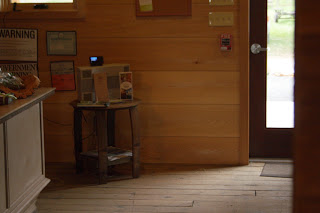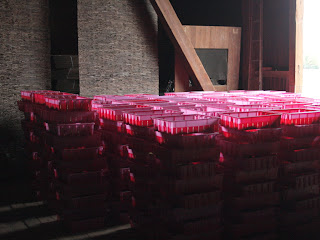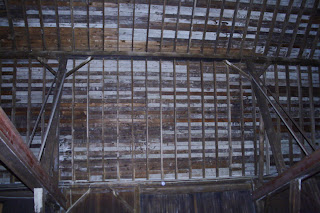
 I like the Finger Lakes region of New York state. I like the way the countryside looks: the long slopes many of them now planted with vines, climbing up from the lakes to the gently rolling plateaus between them; the farms planted with corn, wheat or soy beans; the old farmhouses, mostly square, wood-framed, surrounded by the trees that've grown up around them over the century and a half or more since the houses were built and the farms established; the wineries, their tasting rooms and production facilities mostly dating from the last 30 years or less, built in a variety of styles, surrounded often by their vines; the occasional Amish buggy with its big red reflective triangle and flashing LED safety light on back, pulled by a cantering pony. The towns between the lakes are small. They seem weary and a little worn-out but I've got a feeling there's more life to them than a city boy like me can know because for all of their ramshackleness, they definitely don't seem dying or dead.
I like the Finger Lakes region of New York state. I like the way the countryside looks: the long slopes many of them now planted with vines, climbing up from the lakes to the gently rolling plateaus between them; the farms planted with corn, wheat or soy beans; the old farmhouses, mostly square, wood-framed, surrounded by the trees that've grown up around them over the century and a half or more since the houses were built and the farms established; the wineries, their tasting rooms and production facilities mostly dating from the last 30 years or less, built in a variety of styles, surrounded often by their vines; the occasional Amish buggy with its big red reflective triangle and flashing LED safety light on back, pulled by a cantering pony. The towns between the lakes are small. They seem weary and a little worn-out but I've got a feeling there's more life to them than a city boy like me can know because for all of their ramshackleness, they definitely don't seem dying or dead.

 Along the northern points of the lakes are a series of small cities and towns whose lives I mostly don't know, but whose look is always picturesque. They date from the 1820s and their main streets, both commercial and residential, reflect varying periods of prosperity and want. Skaneateles on the north end of the lake of that name is touristy, with large and small inns, restaurants and lots of boutiques along its main drag. In the summer and during the leaf-peeping season, it's streets are lined with visitors from wherever they come from - I really haven't inquired where, since the largest city nearby is Syracuse, and that hasn't been a hub of prosperity recently. Heading west, along US 20 is Auburn, NY, on the northern end of Owasco Lake. It seems larger and more commercial than either Skaneateles to the east or Seneca Falls to the west. I wonder what drives it, and whether its appearance of middle-class activity is illusory or real. Seneca Falls is west of the northern end of Cayuga Lake, on the canal that connects Seneca and Cayuga lakes. The northern end of the lake is a swampy nature preserve, with eagles' nests planted on the top of the tall power-line pylons that parallel the highway.
Along the northern points of the lakes are a series of small cities and towns whose lives I mostly don't know, but whose look is always picturesque. They date from the 1820s and their main streets, both commercial and residential, reflect varying periods of prosperity and want. Skaneateles on the north end of the lake of that name is touristy, with large and small inns, restaurants and lots of boutiques along its main drag. In the summer and during the leaf-peeping season, it's streets are lined with visitors from wherever they come from - I really haven't inquired where, since the largest city nearby is Syracuse, and that hasn't been a hub of prosperity recently. Heading west, along US 20 is Auburn, NY, on the northern end of Owasco Lake. It seems larger and more commercial than either Skaneateles to the east or Seneca Falls to the west. I wonder what drives it, and whether its appearance of middle-class activity is illusory or real. Seneca Falls is west of the northern end of Cayuga Lake, on the canal that connects Seneca and Cayuga lakes. The northern end of the lake is a swampy nature preserve, with eagles' nests planted on the top of the tall power-line pylons that parallel the highway.Seneca Falls is home to the Women's National Historical Park. It's the site of the birthplace of Women's Rights in the USA, and that's commemorated with historical sites, a sculpture trail, and during the warmer months, lots of events and recreations of the historical moment when those women: Elizabeth Cady Stanton, Lucrecia Mott, et al. gathered together to declare loudly that women are not second class citizens in the American republic. During the off-season, it's a quiet place, with one main street, a few restaurants and shops, but not a lot more. It is also the model for Bedford Falls, the town in "It's a Wonderful Life," and the recently renovated and remodeled old hotel, formerly the Gould, on Falls Street was renamed The Hotel Clarence in honor of that part of the village's heritage. The restaurant in the hotel is worth eating at if you are in town. Seneca Falls is also where we base ourselves for these weekends, at the wonderful John Morris Manor Bed and Breakfast. It is truly a wonderful place to say. I'm a little sad because the owners, John and Tony, have put the place up for sale because they are ready to retire. I hope the next owners are as wonderful a pair of hosts as these.

West of Seneca Falls, still on US 20, is Waterloo, NY, of which I shall not speak because I've never stopped there, so except for it's self-identification as the place where Memorial Day originated, I know nothing of it.

 Geneva, NY sits on the northern end of Seneca Lake. I like Geneva. It's a place I make a point of visiting when I take my vacationlets in the region. It has an attractive downtown despite a few jarring and out of place buildings that break the pattern of mid-19th Century commercial architecture. The city has a few places to eat, a fair number of shops, a few bars and even a couple of galleries. It doesn't feel like a tourist town, though it's attractive enough and well-located to be one, and it doesn't feel like a college town, even though it is the home of Hobart and William Smith Colleges, Finger Lakes Community College and a large bio-research station that's part of the New York State Agricultural Extension.
Geneva, NY sits on the northern end of Seneca Lake. I like Geneva. It's a place I make a point of visiting when I take my vacationlets in the region. It has an attractive downtown despite a few jarring and out of place buildings that break the pattern of mid-19th Century commercial architecture. The city has a few places to eat, a fair number of shops, a few bars and even a couple of galleries. It doesn't feel like a tourist town, though it's attractive enough and well-located to be one, and it doesn't feel like a college town, even though it is the home of Hobart and William Smith Colleges, Finger Lakes Community College and a large bio-research station that's part of the New York State Agricultural Extension.
 I've written about Geneva in previous postings, so I'm not going to spend too much time on that friendly city. I went back to see what the Microclimate Wine Bar had become in the 10 months since I photographed James in the doorway of that then raw space. When I walked by on a Saturday early in April of this year, the place was still in gestation. I was pleased to see that the space was no longer raw, and that it had become a place to talk while sipping wines from the Finger Lakes and the world beyond. The aim was to find wines of different types that expressed their terroir, and while I didn't drink enough to be sure that was indeed the case, the list was diverse enough that it most certainly should prove true to anyone sampling their flights or multiple glasses selected from their list. I'd already had several glasses worth of wine that afternoon, visiting several wineries (Fox Run, White Springs and Ravines) so more would've been simply too much.
I've written about Geneva in previous postings, so I'm not going to spend too much time on that friendly city. I went back to see what the Microclimate Wine Bar had become in the 10 months since I photographed James in the doorway of that then raw space. When I walked by on a Saturday early in April of this year, the place was still in gestation. I was pleased to see that the space was no longer raw, and that it had become a place to talk while sipping wines from the Finger Lakes and the world beyond. The aim was to find wines of different types that expressed their terroir, and while I didn't drink enough to be sure that was indeed the case, the list was diverse enough that it most certainly should prove true to anyone sampling their flights or multiple glasses selected from their list. I'd already had several glasses worth of wine that afternoon, visiting several wineries (Fox Run, White Springs and Ravines) so more would've been simply too much. The room was divided at its center by the bar, which sits eight. Between the bar and the street are a handful of small tables and a counter. Beyond the bar, a lounge-like space that invited its customers to relax and think about the wine as well as the world. The basement, partially finished - and recommended by the Genovese sisters, two delightful locals who I met early in the afternoon while browsing in the antiques co-op on Exchange Street - was cavelike, which might make it the perfect place for a wine-tasting event. All that was missing from it were rows of wine aging in their casks.
The room was divided at its center by the bar, which sits eight. Between the bar and the street are a handful of small tables and a counter. Beyond the bar, a lounge-like space that invited its customers to relax and think about the wine as well as the world. The basement, partially finished - and recommended by the Genovese sisters, two delightful locals who I met early in the afternoon while browsing in the antiques co-op on Exchange Street - was cavelike, which might make it the perfect place for a wine-tasting event. All that was missing from it were rows of wine aging in their casks. Best of all, the mix of friendly ambience and good wine make for an almost ideal place to plop one's butt on a chair or stool, since there's no butts for butts, sniff and sip wine, chat with the others about both the wine and the state of the world, before returning to the harsh reality outside the doors. My congratulations to Stephanie Mira de Orduña and James-Emery Elkin for seeing this through from conception to operation. I am sure we'll be going back there again.
Best of all, the mix of friendly ambience and good wine make for an almost ideal place to plop one's butt on a chair or stool, since there's no butts for butts, sniff and sip wine, chat with the others about both the wine and the state of the world, before returning to the harsh reality outside the doors. My congratulations to Stephanie Mira de Orduña and James-Emery Elkin for seeing this through from conception to operation. I am sure we'll be going back there again. Also on Linden Street is a former bank turned into a gallery. It was bare when we went by, but it is great to see these sorts of things happening here.
Also on Linden Street is a former bank turned into a gallery. It was bare when we went by, but it is great to see these sorts of things happening here.Earlier, visiting the new tasting room that Ravines established just south of Geneva in an old barn that was also the production facility for both White Springs and for the Ravines expansion, there were grapes recently picked, still on their flats, waiting for their time in the press. In case you don't know it, you ought to: Ravines is one of the best producers in the region.

I should mention that Ravines' new tasting room is off of Pre-Emption Road. It's an odd name with an interesting story. It seems that in the 17th and 18th Centuries, the regions of Central and Western NY State were claimed by various entities, all the while occupied by the Iroquois Nations. There were French, Spanish, Dutch and English claims, and the English claims broke down to claims by the colonies of Virginia, Pennsylvania, Massachusetts and New York. By the late 18th Century, the French, the Dutch and the Spanish were gone, Virginia and Pennsylvania had abandoned their claims, but Massachusetts and New York continued to dispute sovereignty and ownership. For various reasons of state, Massachusetts and New York negotiated an agreement that set the eastern boundary of New York where it is now, and ceded most of the region to New York once the land was sold. A line was drawn and surveyed. East of the line, New York controlled the land. West of it, Massachusetts had the pre-emptive right to dispose of the land, and once the land was sold, it fell under New York State control. In 1788 a line was surveyed from the Pennsylvania border north toward Lake Ontario. For reasons that have never been fully determined, but most likely due to faulty methods, that survey line was off by a couple of degrees so that by the time the line was surveyed to Geneva, NY, that village was on the eastern side of the line. A new survey in 1792, using better instruments and methods, put the line through Seneca Lake, a few miles to the east.

There are still surviving indicators of that initial survey, and in Ontario County, New York, County Rt. 6, Pre-emption Road is one of them. There are articles of some depth available on line, such as this one, at the Crooked Lake Review by Alfred G. Hilbert
Dinner, at the recommendation of two sisters from Canandaigua who come to Geneva to drink and eat, was at Halsey's on Seneca St. Even at 6PM, early on a Saturday evening, the restaurant was fully booked so we ate at the bar. It was no sacrifice. The bartender was as attentive to her customers as she was skilled at mixing cocktails. The food was fine. I had their spicy calamari as an appetizer and a margarita pizza out of their wood-fire oven for my main course. Both were very well made. The pizza was better than I expected - much better, and when I was done I thought I'd have to come back for more.
Sunday morning we took a leisurely drive down the eastern shore of Seneca Lake. It was too early for Lamoreaux Landing to be open but Damiani was ready for us. They make a refreshing array of reds, and I happily recommend their 2007 Meritage and 2008 Cabernet Franc. I had a sip of their Brut Sparkling wine and I'm looking forward to popping the cork on the bottle we bought.
Permanent link to this entry:
http://kayester.blogspot.com/2012/10/yet-another-weekend-break-in-fingerlakes.html
Fox Run Vinyards:
White Springs
Ravines Vineyards tasting room in Geneva:
Linden St., Geneva NY
The Microclimate Wine Bar
Lamoreaux Landing
Damiani Wine Cellars
Permalink: http://kayester.blogspot.com/2012/10/yet-another-weekend-break-in-fingerlakes.html





















































No comments:
Post a Comment
Leave a comment if you wish. Comments will be moderated.